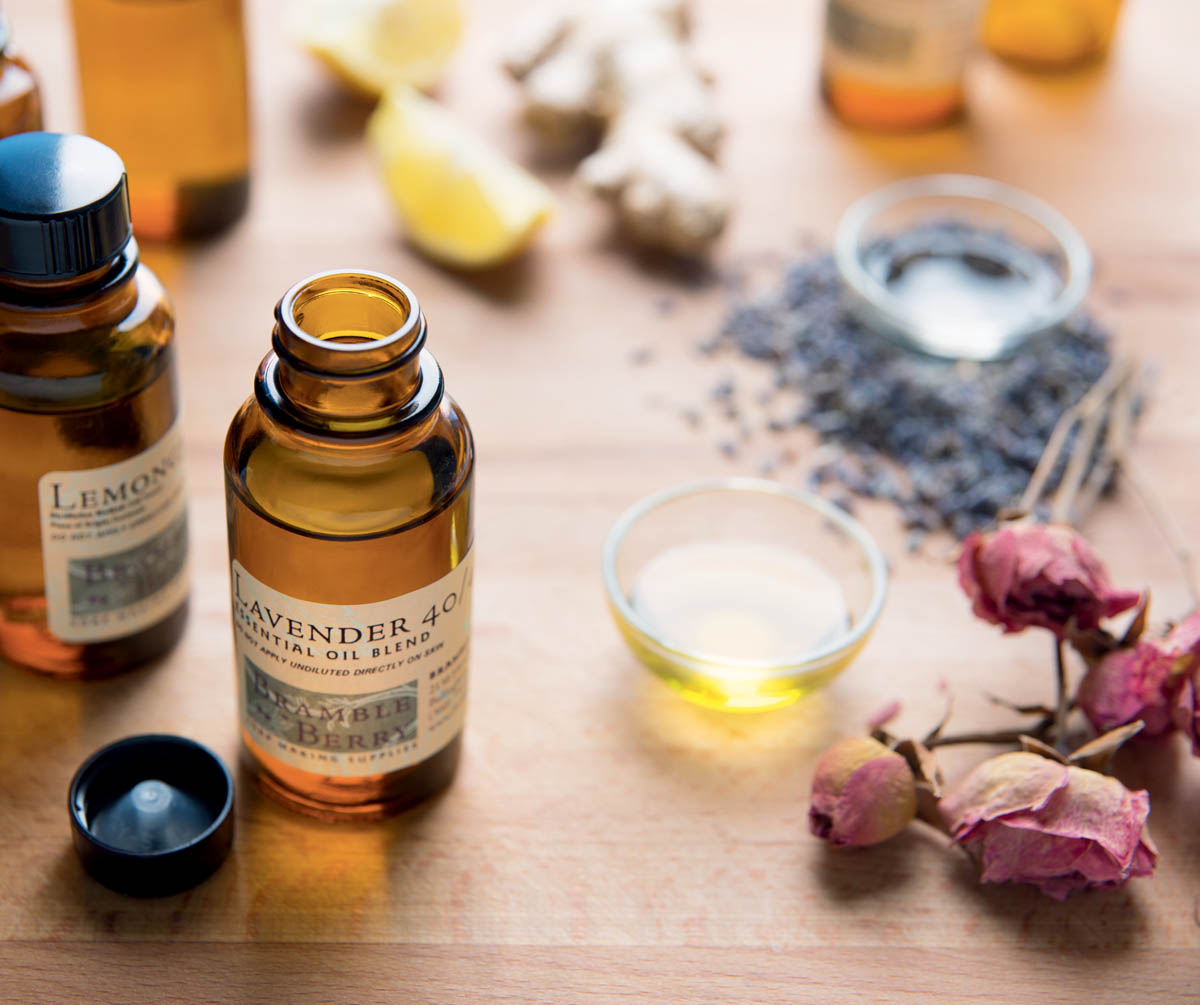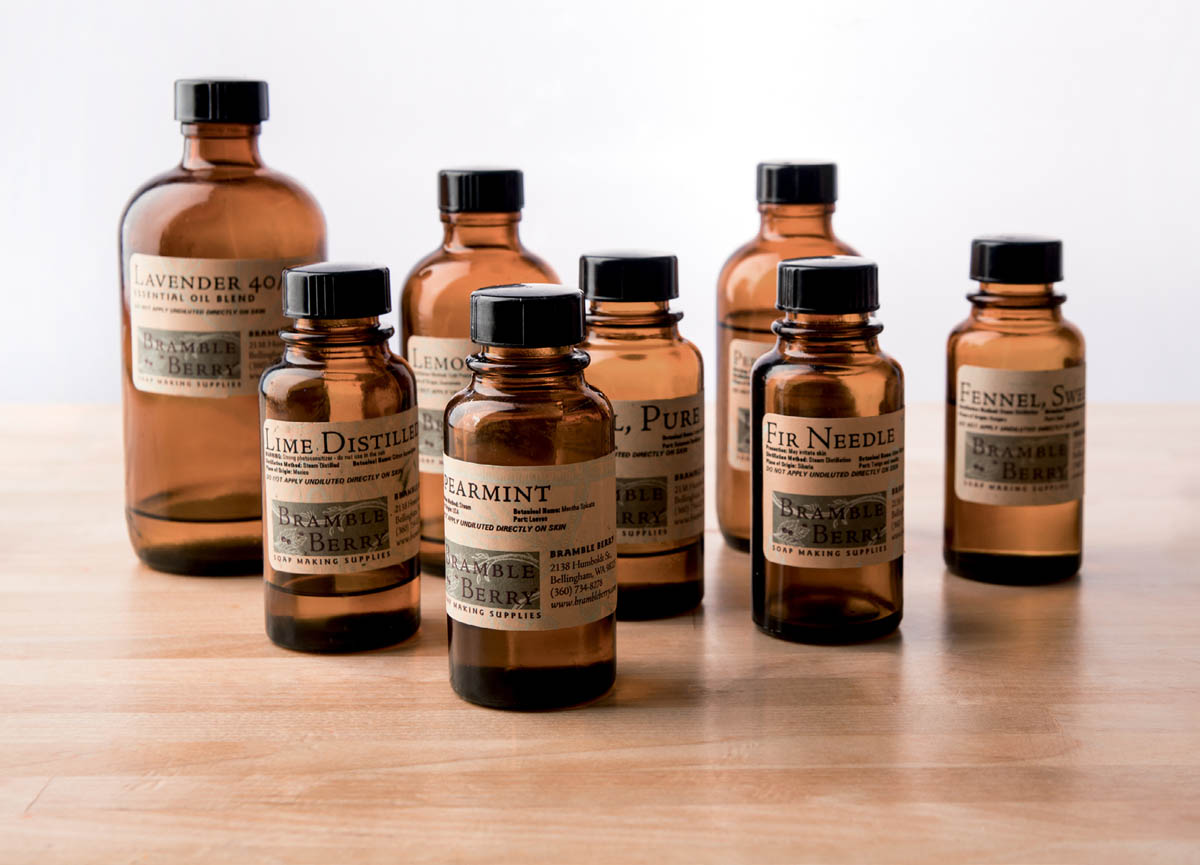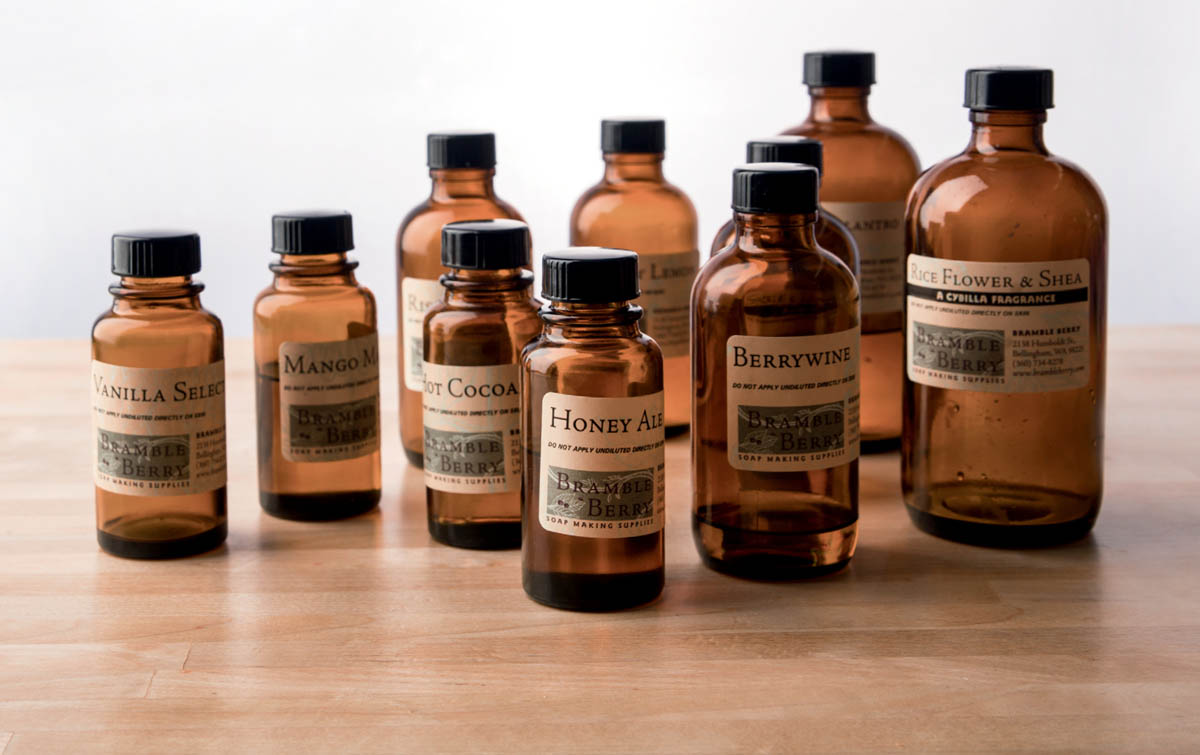
Another creative aspect of soapmaking is the art of fragrance. There are two types of additives that will make soap smell good: essential oils and fragrance oils. Candy flavoring and baking extracts do not work well for adding fragrance to cold-process soap. They generally do not survive the high pH of the soapmaking process, leaving you with unscented or under-scented soap.

Essential oils come from all-natural, plant-based materials obtained from leaves, bark, peels, twigs, or flowers. The most common way to extract essential oils is by steam distillation. The plant material is mixed with a large amount of water in a special tank and brought to a boil, causing the oils from the plant material to evaporate. As the water cools, the essential oils separate from the water. The fragrant water that remains, called a hydrosol, is often used as a base in lotions and face creams.
Another common method for extracting essential oils is manual extraction (pressing). Most citrus oils are extracted by pressing the skin of the fruit. The high heat from steam distillation can damage gentle citrus essential oils and is an inefficient way to extract large quantities of essential oil from the peel.
A less common method is enfleurage, which involves placing flowers between two solid layers of fat (usually an animal-based fat) and replacing the flowers daily until the fat has taken up enough oil from them to become fully saturated with scent. The resulting material is called a concrete. Concretes are not generally used in soapmaking because they are expensive and somewhat delicate to work with.
Oils can also be produced with a solvent extraction. Flowers are covered with a chemical solvent (such as hexane) that extracts the essential oil. The solvent is usually evaporated, leaving behind an oily mixture called an absolute. For the same reasons as concretes, absolutes are generally not used in soapmaking. Some soapers also prefer not to use them because of the chemicals involved in the extraction process.
With the exception of solvent-extracted essential oils (which can contain trace amounts of the chemicals used to extract the oils), essential oils are all natural. That is, they are produced from natural oil-bearing plants in processes that use other materials found in nature. You cannot, for example, have a chocolate essential oil or a cherry essential oil, because neither ingredient produces oil. Cherries produce a wonderful juice that could be used in the soapmaking process but it wouldn’t impart any fragrance.
Even though they are all natural, essential oils must be used with care. For example, clove and cinnamon leaf are skin irritants and therefore should be used sparingly in soap. Some essential oils are contraindicated for pregnant women or individuals with high blood pressure or other health conditions.
Use only those essential oils that you know are safe. If you want to experiment with one that you are not familiar with, research its properties thoroughly beforehand. Read books, look online, or call the vendor for information.
The following essential oils should never be used in soap or any other bath or body product:
Note that not all essential oils are stable in cold-process soap. For example, orange essential oil smells amazing in the bottle, but in soap it withers a slow and painful death, leaving no scent behind. Before you purchase an essential oil for the first time, ask other soapers or the vendor how that oil will do in the difficult environment of raw soap batter.

The following essential oils are typically wonderful in cold-process soap:
Other essential oils not listed here may work in your soap depending on how they have been extracted. For example, redistilled orange essential oil (often referred to as orange 5× or 10×) will last in cold-process soap, whereas a traditional distillation of orange essential oil will not. The best way to find out about an unfamiliar essential oil is first to ask questions and then, if your research suggests it may be suitable, to use it in a small test batch of soap.
Different batches of the same essential oil may smell slightly different due to any of several factors. Like wines, essential oils are affected by the weather, by nutrients in the soil, and by harvest conditions. And as with wine, annual crop conditions also affect prices. If less oil is harvested than expected for the year, the price generally goes up.
Sourcing can be a concern for those who use only essential oils in their soap. Plan ahead a year or so and purchase enough to last through the next growing season if you are concerned about the scarcity of a particular oil.
One thing to be aware of is that essential oils can be easily adulterated by unscrupulous vendors. For example, rose essential oil can cost around $250 an ounce because it takes more than 4,000 pounds of rose petals to make 16 ounces of the oil. That is a lot of roses! To make it more profitable, a vendor may stretch or extend an oil by adding other materials to it.
It is extremely important that you purchase your essential oils from a trustworthy source. Ask your vendors if they do spot checks on their essential oils to confirm that there has been no adulteration in the process. If you are ever concerned or suspicious about a product you have purchased, you can pay for a chemical analysis from a lab (see Resources).
Fragrance oils, created by fragrance companies, are proprietary blends of natural oils, synthetic materials, and nature-identical chemicals (i.e., synthetic but chemically equivalent to natural oils). Unlike essential oils, fragrance oils are not considered all natural. If you would like to make an all-natural soap, stick with essential oils. If you would like a wider array of choices — like chocolate, blueberry, or bubble gum — fragrance oils are an excellent option. Fragrance oils also remain more stable in pricing than do essential oils and do not suffer shortages due to crop instabilities. Additionally, some fully tested soap fragrance oils produce a stronger smell in the finished product than do some essential oils — this is especially true in the citrus family.
More than 3,500 ingredients are approved for use in fragrance oils, but you won’t see them listed on the bottle. Fragrance manufacturers are exempt from full ingredient disclosure because of laws pertaining to trade secrets. Perfumers consider themselves artists who create unique blends, and disclosure requirements would allow competing perfumers to easily copy one another.
Additionally, many of the ingredients in fragrance oils have long names like cyclopentaneacetic acid, 3-oxo-2-pentyl-methyl ester, and even 1,3,4,6,7,8-hexahydro-4,6,6,7,8,8-hexamethylcyclopenta-gamma. With some fragrances containing up to 100 ingredients, putting them all on the labels could be more confusing than helpful and would probably make the labels too big to fit on the bottles!
Fragrance oils are not regulated by the U.S. Food and Drug Administration, but fragrance oil manufacturers do have to follow testing and safety regulations established by the Research Institute for Fragrance Materials (RIFM). RIFM was formed in 1966 to analyze, evaluate, and distribute scientific data; cooperate with official agencies; and encourage safety standards for the use of fragrance ingredients. RIFM’s team of independent experts includes dermatologists, pathologists, environmental scientists, and toxicologists who evaluate fragrance ingredients and determine safety standards for them. RIFM publishes ingredient lists, conducts safety assessments, and then turns the data over to the International Fragrance Association (IFRA), the official representative body of the fragrance industry. IFRA develops standards on fragrance materials and suggests usage rates for fragrance oils.

When you purchase fragrance oils, check with the vendor to make sure that the oils have been tested in the cold-process method for soapmaking. Ideally, the vendor will have testing notes that will help guide you to ensure that your fragrance is as compatible as possible with your recipe. Manufacturers of candle fragrances and potpourri fragrances do not follow the same stringent safety guidelines that makers of skin-safe fragrances follow. When making soap, use only skin-safe fragrances and follow the usage-rate guidelines from the supplier.
A general rule for essential oils and fragrance oils is to add 0.5 to 1.0 ounce of oil per pound of soap. With a particularly strong essential oil or fragrance oil, you can use less than 0.5 ounce and still create a pleasantly fragrant soap. However, with a weak essential oil or fragrance oil, adding more than 1.0 ounce per pound of soap will usually not strengthen the scent.
If you are using a fragrance oil that has not already been fully tested in cold-process soap, make a test batch of 1 pound or less before trying it in larger amounts. While most fragrance oils can be used with no problems at all, some can throw your soap into a tailspin in a number of ways, including the following:
Accelerate the trace, making your soap thicken very quickly.
Seize the soap, creating a rock-hard lump before you even have time to blink.
Separate the soap mixture, producing a strange, oily, curdy mess.
You add the fragrance oil when your soap is at thin trace (the consistency of a melted milkshake), after you’ve added the colorant. If you add the fragrance before the colorant and the fragrance accelerates trace or causes the batter to separate, you may be left with white or unevenly colored soap. Hand stirring at thin trace is the best way to add fragrances to your soap. Mix until the fragrance is fully blended. If the fragrance is behaving particularly well, you can use the stick blender, but only for fragrances you’re certain perform well in cold-process soap.